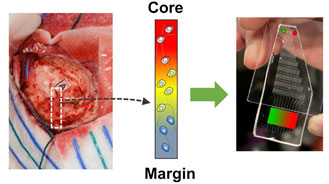Crossref Citations
This article has been cited by the following publications. This list is generated based on data provided by
Crossref.
Accardo, Angelo
Shalabaeva, Victoria
and
LaRocca, Rosanna
2018.
Colon cancer cells adhesion on polymeric nanostructured surfaces.
MRS Communications,
Vol. 8,
Issue. 1,
p.
35.
Magariños, Ana M.
Pedron, Sara
Creixell, Marc
Kilinc, Murat
Tabansky, Inna
Pfaff, Donald W.
and
Harley, Brendan A. C.
2018.
The Feasibility of Encapsulated Embryonic Medullary Reticular Cells to Grow and Differentiate Into Neurons in Functionalized Gelatin-Based Hydrogels.
Frontiers in Materials,
Vol. 5,
Issue. ,
Nam, Sung-Wook
2018.
200 mm wafer-scale fabrication of polydimethylsiloxane fluidic devices for fluorescence imaging of single DNA molecules.
MRS Communications,
Vol. 8,
Issue. 2,
p.
420.
Chen, Jee-Wei E.
Pedron, Sara
Shyu, Peter
Hu, Yuhang
Sarkaria, Jann N.
and
Harley, Brendan A. C.
2018.
Influence of Hyaluronic Acid Transitions in Tumor Microenvironment on Glioblastoma Malignancy and Invasive Behavior.
Frontiers in Materials,
Vol. 5,
Issue. ,
Hubka, Kelsea M.
Carson, Daniel D.
Harrington, Daniel A.
and
Farach-Carson, Mary C.
2019.
Perlecan domain I gradients establish stable biomimetic heparin binding growth factor gradients for cell migration in hydrogels.
Acta Biomaterialia,
Vol. 97,
Issue. ,
p.
385.
Sun Han Chang, Raul
Lee, Johnny Ching-Wei
Pedron, Sara
Harley, Brendan A. C.
and
Rogers, Simon A.
2019.
Rheological Analysis of the Gelation Kinetics of an Enzyme Cross-linked PEG Hydrogel.
Biomacromolecules,
Vol. 20,
Issue. 6,
p.
2198.
Pedron, Sara
Wolter, Gabrielle L.
Chen, Jee-Wei E.
Laken, Sarah E.
Sarkaria, Jann N.
and
Harley, Brendan A.C.
2019.
Hyaluronic acid-functionalized gelatin hydrogels reveal extracellular matrix signals temper the efficacy of erlotinib against patient-derived glioblastoma specimens.
Biomaterials,
Vol. 219,
Issue. ,
p.
119371.
Lavrentieva, Antonina
2020.
Tunable Hydrogels.
Vol. 178,
Issue. ,
p.
227.
Jo, Heejung
Yoon, Minhyuk
Gajendiran, Mani
and
Kim, Kyobum
2020.
Recent Strategies in Fabrication of Gradient Hydrogels for Tissue Engineering Applications.
Macromolecular Bioscience,
Vol. 20,
Issue. 3,
Xiao, Weikun
Wang, Shanshan
Zhang, Rongyu
Sohrabi, Alireza
Yu, Qi
Liu, Sihan
Ehsanipour, Arshia
Liang, Jesse
Bierman, Rebecca D.
Nathanson, David A.
and
Seidlits, Stephanie K.
2020.
Bioengineered scaffolds for 3D culture demonstrate extracellular matrix-mediated mechanisms of chemotherapy resistance in glioblastoma.
Matrix Biology,
Vol. 85-86,
Issue. ,
p.
128.
Liu, Peng
Griffiths, Scott
Veljanoski, Damjan
Vaughn-Beaucaire, Philippa
Speirs, Valerie
and
Brüning-Richardson, Anke
2021.
Preclinical models of glioblastoma: limitations of current models and the promise of new developments.
Expert Reviews in Molecular Medicine,
Vol. 23,
Issue. ,
Unal, Semra
Arslan, Sema
Yilmaz, Betul Karademir
Oktar, Faik Nuzhet
Sengil, Ahmet Zeki
and
Gunduz, Oguzhan
2021.
Production and characterization of bacterial cellulose scaffold and its modification with hyaluronic acid and gelatin for glioblastoma cell culture.
Cellulose,
Vol. 28,
Issue. 1,
p.
117.
Chang, Chun-Yi
and
Lin, Chien-Chi
2021.
Hydrogel Models with Stiffness Gradients for Interrogating Pancreatic Cancer Cell Fate.
Bioengineering,
Vol. 8,
Issue. 3,
p.
37.
Zhu, Danqing
Trinh, Pavin
Li, Jianfeng
Grant, Gerry A.
and
Yang, Fan
2021.
Gradient hydrogels for screening stiffness effects on patient‐derived glioblastoma xenograft cellfates in 3D.
Journal of Biomedical Materials Research Part A,
Vol. 109,
Issue. 6,
p.
1027.
Goodarzi, Kasra
and
Rao, Shreyas S.
2021.
Hyaluronic acid-based hydrogels to study cancer cell behaviors.
Journal of Materials Chemistry B,
Vol. 9,
Issue. 31,
p.
6103.
Hassani, Iman
Anbiah, Benjamin
Kuhlers, Peyton
Habbit, Nicole L
Ahmed, Bulbul
Heslin, Martin J
Mobley, James A
Greene, Michael W
and
Lipke, Elizabeth A
2022.
Engineered colorectal cancer tissue recapitulates key attributes of a patient-derived xenograft tumor line.
Biofabrication,
Vol. 14,
Issue. 4,
p.
045001.
Cheng, Sha
Chen, Wen
and
Zhang, Pengchao
2022.
Developing advanced polymer films based on microfluidic laminar flow.
Giant,
Vol. 9,
Issue. ,
p.
100091.
Ursini, Ornella
Grieco, Maddalena
Sappino, Carla
Capodilupo, Agostina Lina
Giannitelli, Sara Maria
Mauri, Emanuele
Bucciarelli, Alessio
Coricciati, Chiara
de Turris, Valeria
Gigli, Giuseppe
Moroni, Lorenzo
and
Cortese, Barbara
2023.
Modulation of Methacrylated Hyaluronic Acid Hydrogels Enables Their Use as 3D Cultured Model.
Gels,
Vol. 9,
Issue. 10,
p.
801.
Zambuto, Samantha G.
Kolluru, Samyuktha S.
Harley, Brendan A.C.
and
Oyen, Michelle L.
2024.
Gelatin methacryloyl biomaterials and strategies for trophoblast research.
Placenta,
Vol. 157,
Issue. ,
p.
67.
